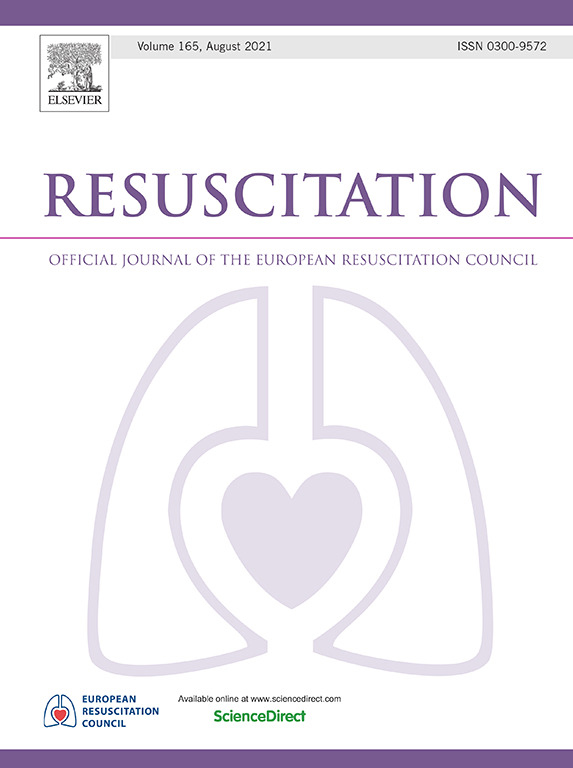公共除颤器记录的初始心律和心律转换。
IF 4.6
1区 医学
Q1 CRITICAL CARE MEDICINE
引用次数: 0
摘要
背景:院外心脏骤停(OHCA)的研究主要集中在紧急医疗服务到达后的事件。公共访问除颤器(pad)记录旁观者复苏期间的心律,并包含早期心律的知识。本研究调查了旁观者使用pad记录的OHCA病例的心律。方法:将2016-2021年的PAD数据与丹麦心脏骤停登记处的OHCA病例合并。人工检查PAD的心律分析(每2-3分钟自动执行一次)。心律分为可震性(室性颤动或室性心动过速)和非可震性。生存率采用多变量logistic回归评估。结果:在3179例OHCA病例中,559例有PAD数据,26% (n=152)有初始震荡节律。与非休克组相比,休克组包括更多的男性(75.7%对58.7%),中位年龄更低(69岁对74岁)。休克节律患者的自发循环恢复率(ROSC)和30天生存率分别为61% (n=93)和40% (n=61)(优势比为9.02 [95%CI: 4.99-16.9])。在非休克病例中,ROSC和生存率分别为17% (n=69)和5% (n=20)。8.8% (n=30)的患者转为休克性心律,但与生存率的提高无关(优势比0.82 [95%CI: 0.25-2.25];转为休克性心律的生存率为10%,未转为休克性心律的生存率为4.5%,p = 0.41)。没有超过5个连续震荡节律的患者存活。结论:pad记录的初始心律是OHCA的重要预后因素。即使有心律转换,非休克病例的存活率也很低。利用PAD数据可以支持OHCA护理的临床决策。本文章由计算机程序翻译,如有差异,请以英文原文为准。
Initial cardiac rhythm and rhythm conversion recorded by public access defibrillators
Background
Out-of-hospital cardiac arrest (OHCA) research primarily focus on events after emergency medical services arrive. Public access defibrillators (PADs) record cardiac rhythms during bystander resuscitation and contain knowledge on early cardiac rhythms. This study investigated cardiac rhythms in OHCA cases recorded by PADs used by bystanders.
Methods
PAD data from 2016 to 2021 were merged with OHCA cases from the Danish Cardiac Arrest Registry. The cardiac rhythm analyses from the PAD (performed automatically every 2–3 min) were manually reviewed. Cardiac rhythms were classified as shockable (ventricular fibrillation or ventricular tachycardia) or non-shockable. Survival was assessed using multivariable logistic regression.
Results
Among 3179 OHCA cases, 559 had PAD data and 26 % (n = 152) had an initial shockable rhythm. Compared to the non-shockable group, the shockable group included more males (75.7 % vs 58.7 %) and median age was lower (69 vs 74 years). The rate of return of spontaneous circulation (ROSC) and 30-day survival for shockable rhythms were 61 % (n = 93), and 40 % (n = 61), respectively (odds ratio 9.02 [95 %CI: 4.99–16.9] compared to non-shockable). In non-shockable cases, ROSC and survival were 17 % (n = 69) and 5 % (n = 20), respectively. Conversion to shockable rhythms occurred in 8.8 % (n = 30), however not associated with improved survival (odds ratio 0.82 [95 %CI: 0.25–2.25]; survival with conversion 10 %, without conversion 4.5 %, p = 0.41). No patients with more than five consecutive shockable rhythms survived.
Conclusions
Initial PAD-recorded rhythm is an important prognostic factor in OHCA. Survival is poor in non-shockable cases, even with rhythm conversion. Utilizing PAD data may support clinical decision-making in OHCA care.
求助全文
通过发布文献求助,成功后即可免费获取论文全文。
去求助
来源期刊

Resuscitation
医学-急救医学
CiteScore
12.00
自引率
18.50%
发文量
556
审稿时长
21 days
期刊介绍:
Resuscitation is a monthly international and interdisciplinary medical journal. The papers published deal with the aetiology, pathophysiology and prevention of cardiac arrest, resuscitation training, clinical resuscitation, and experimental resuscitation research, although papers relating to animal studies will be published only if they are of exceptional interest and related directly to clinical cardiopulmonary resuscitation. Papers relating to trauma are published occasionally but the majority of these concern traumatic cardiac arrest.
 求助内容:
求助内容: 应助结果提醒方式:
应助结果提醒方式:


